Ioana V. Pribiag
If two decades ago, according to Bill Marshall, “no Québec film [had] yet articulated the full symbolic and narrative potential that lies within the relationship between native peoples and Canadiens/Québécois,” this is no longer the case today.1 A progressive flourishing of Indigenous media in Québec has emerged from the conjuncture of Native communities’ relentless political struggles, on the one hand, and the substantial Canadian and provincial support of multiculturalism in the arts on the other. National Film Board (NFB/ ONF) initiatives beginning in the 1960s, the development of the Aboriginal Peoples Television Network (APTN) in the 1990s and cross-cultural collaborations such as the Arnait Women’s Collective and Wapikoni Mobile have resulted in the production of hundreds of documentary and fiction shorts, feature films, music videos and television series.2 These works mark a turn- ing point toward “visual” or “representational sovereignty.”3 They protect cultural heritages and languages, promote the dissemination of cultures and experiences and combat isolation and alienation in First Nations’ communities. Many of these productions additionally create opportunities for mutually enriching encounters between First Nations and non-Indigenous people. Such encounters begin to bridge the cultural and geographical distances separating Native peoples and Québécois, opening the way for what Marshall had called a “métissage to be rediscovered.”4 This gradually unfold- ing cinematic corpus constitutes, according to Karine Bertrand, “une nou- velle géographie (trans-nationale) symbolique et identitaire.”5 For Bertrand, cinema is a privileged medium for this “toile nouvelle d’une culture métis- sée” destined to break down racial, political and social divides.6
Marshall and Bertrand’s turn to the notion of métissage is not self-evident. It is a less frequently emphasized dimension of studies on Indigenous cinema, which overwhelmingly tend to stress self-representation. This phenomenon is understandable, given that Native works are responding to over a century’s worth of filmic conventions objectifying and othering Indigenous subjects. Michelle Raheja’s concept of “visual sovereignty,” for instance, calls on “Indigenous people to express reality in their own voices.”7 For Raheja, the emancipatory force of creative self-representation extends beyond critique and revision; she explains it is also a matter of what Robert Allen Warrior calls “intellectual health.”8 Similarly, Kerstin Knopf claims that, “for Indigenous filmmakers, decolonization starts when they take their image-making and self-representation into their own hands, creating decolonized cultural, historical, and political discourses.”9 The redundancy of Knopf’s formulation highlights the sense of urgency informing her argument. Nevertheless, many scholars of Indigenous cinema simultaneously recognize the difficulty of defining what constitutes an “Indigenous film.” Is an Indigenous director sufficient to earn this title, even if the cast and crew are non-Indigenous? What about the inverse? Does the content of the narrative need to be informed by Indigenous themes or cultural issues? As Miléna Santoro notes, advocating for a restrictive imperative of self-representation involves a risk of falling into essentialism and excluding films that might not have been made by Indigenous directors, yet are committed to decolonizing discourses and images of Aboriginal peoples.10 We should therefore be wary of maintaining rigid oppositions between Self and Other that can ultimately entrench colonial divides. As Kwame Anthony Appiah powerfully explains, even “the celebration of oneself as Other” can become a form of anxious “alteritism,” a mechanical “manufacture of alterity” against a monolithic West that only continues structures of domination in another form.11
Métissage runs its own risks, of course, especially in a context where the promotion of biological hybridity has a historical connection to colonial assimilation. Moreover, Laurent Dubreuil’s nuanced critique of the term reminds us of the extent to which the imperative of métissage can continue to serve an ethnocentric ideology, reducing the dominant culture’s “Other” to an ornamental function.12 While remaining skeptical toward the term, I nevertheless view its emphasis on relation as a crucial contribution to the emerging critical corpus on Indigenous cinema. Because métissage relies on a dialectic between cultural specificity and exchange, it is a potential catalyst for troubling both a facile universalism and identitarian discourses that might tend toward solipsistic withdrawal. This uneasy label provides a framework for considering films that, regardless of their point of origin, open a space for an authentic Indigenous prise de parole or explore the inescapable porosity of cultural boundaries.
It is from this perspective that this article examines Kuessipan (2019), Myriam Verreault’s collaborative adaptation of Innu writer Naomi Fontaine’s eponymous novel. The film is one of the most highly acclaimed productions within Québec’s shifting, transnational cinematic landscape. Kuessipan is a coming-of-age story from the perspective of a young Innu girl, Mikuan, who aspires to become a writer. Her dream involves leaving the Uashat reserve to attend university in Québec City at the same time as she aspires to celebrate the beauty and resilience of her community. The film focuses on Mikuan’s relationships with her family and her Innu friend, Shannis, as well as on her romance with a white Québécois boyfriend, Francis, which comes to an abrupt end following the untimely death of Mikuan’s brother in a car accident. The film represents the inspiring creation of a hybrid voice that challenges both exotic or naïve representations of “the Indigenous Other” and falsely homogenous representations of a Québécois identity. It operates a decentering of otherness, by which I not only mean that otherness is no longer perceived by and for a hegemonically centered Self. This process implies a much more profound epistemological and relational shift, in which the center itself is othered, the Other becomes (a) center, and there is a general deconstruction of these categories toward plurality and equality. Kuessipan moves beyond relations of victimization or narratives revolving around a white savior/mediator and rather opens a space of productive exchange and solidarity that is emblematic of what Michael Gott and Thibaut Schilt name cinéma-monde. Cinéma-monde shares and intensifies the decentering impetus of littérature-monde; it constitutes “lateral connections” and “‘encounters’ between different cultures and perspectives” within the French-speaking world.13 However, cinema’s visual and aural dimensions, as well as the use of subtitles, can bypass language barriers in a unique way, which makes ciné- ma-monde a more viable concept than its controversial literary counterpart. Importantly, for Gott and Schilt, “cinéma-monde becomes more than a potentially useful classification when the encounter […] sparks solidarity, or at least recognition of a shared experience. The two (or more) interlocutors must forge some sort of connection via a common marginal or alternative position or a shared ethic.”14
This article explores how such encounters are mobilized by Kuessipan through the filmmaking process, within the film’s narrative and in its aesthetic construction and interpellation of viewers (notably through the use of maps and close ups). I examine the ethical implications of these dimensions and show how, much like Fontaine’s novel, the film speaks to a subtly adversarial understanding of the encounter, working against the stereotyping settler gaze through its corrective, lyrical portraits. As a form of cinematic métissage or cinéma-monde, Kuessipan goes beyond facile interactions to inscribe a polyvalent call, both hommage and invitation, to openness and responsibility.
Filmmaking as Cultural Métissage
The encounters behind the making of Kuessipan’s project are in many ways as important as those taking place on screen and with the audience. In particular, Verreault and Fontaine’s collaboration on the film’s screenplay is already an act of métissage. The two artists describe in several interviews their connection and the long, involved process of bringing the work to life. Returning to the rich resonances of the word “kuessipan,” meaning “your turn,” Verreault explains that:
le titre fait écho non seulement à l’histoire, mais aussi au processus de création. Il y avait quelque chose à transmettre, une sorte de passation de flambeau pour que le film puisse exister. Naomi a d’abord accepté de me transmettre son livre Kuessipan, mais elle m’a aussi transmis une volonté et un savoir.15
On her end, Fontaine has described feeling hesitant when Verreault first contacted her about working together on a film, because she was concerned that the resulting adaptation could end up perpetuating stereotypes.16 The pair were in agreement, however, that they were not looking to display clichés or sensationalism, and Fontaine welcomed Verreault to Uashat in the summer of 2012. Verreault’s immersion in the Innu community was the beginning of the seven-year, truly collaborative process of bringing Kuessipan to the screen. Verreault and Fontaine were in constant communication throughout the script-writing process. Despite multiple difficulties with funding and the resulting sixteen rounds of revision, Verreault explained that Fontaine “s’est imposée comme la gardienne de la culture et de l’esprit du projet”.17 Meanwhile, Fontaine viewed Verreault’s film as an opening for the novel to gain new meanings.
Openness characterizes both works, as different as they are from each other. The openness of the address to the Other—kuessipan—was multiplied further in the production process, as almost all of the actors were members of the Innu community without any professional acting experience. Verreault decided to cast the film in such a way that the actors’ personalities and experiences could inform the construction of the characters and plot. They shared their stories with her, adding a layer of meaningful authenticity to the film. While making funding more challenging, training and working with nonprofessional actors intensified the extent to which the community felt invested in the project, learned from it and became proud of its result. In fact, when the Kanata controversy broke out in 2018 around the topic of cultural appropriation, Verreault’s project received renewed support from the Innu cast and team.18 Fontaine’s comments on the controversy, in comparing the two approaches, are enlightening:
Pour Kanata, Lepage, dont j’aime beaucoup le travail, s’est privé de quelque chose. Il s’est privé d’une rencontre. Ce qu’on a critiqué, c’est le fait de ne pas avoir inclus les Autochtones [sic] d’une manière ou d’une autre… [Verreault] l’a fait avec respect, elle l’a fait avec nous, d’égal à égal… Peut- être que le film est une forme d’appropriation culturelle. Si oui, c’est la plus belle façon de le faire, c’est-à-dire ensemble. Ce qui importe c’est la manière. Pour être claire, je ne crois pas à l’appropriation au sens qu’on lui donne maintenant. Je crois à l’échange, au partage.19
Fontaine emphasizes the crucial role of the intercultural encounter in the creative process. She sidesteps the misguided isolationism subtending debates around cultural appropriation, posing instead the question of the ethical import of equality and connection. Because of the deep collaboration between Fontaine and Verreault, the film became a source of community pride for the Innu, as well as a point of contact between Uashat and Sept-Îles. In analyzing the film itself, it is important not to lose sight of this very real impact that the production process can have on people and on communities. Verreault recalls that at the Sept-Îles premiere, “les deux communautés part- ageaient les rires autant que les larmes pendant toute la projection.”20 In the end, the director explains that it is the transformative process of making the film that she found most rewarding: “[J]e suis encore plus fière du processus que du résultat. Le résultat c’est le film et je l’aime bien, mais le processus a duré sept ans et a été enrichissant pour tout le monde.”21 Kuessipan thus exemplifies the generative and liberating power of intercultural encounter and exchange, not just in its content, but also in Verreault and Fontaine’s commitment to relational and ethical filmmaking.
Decentering Subject and Space
[T]he violence of a racialized society falls most enduringly on the details of life: where you can sit, or not; how you can live, or not; what you can learn, or not; who you can love, or not.
Homi K. Bhabha22
Narratively, Kuessipan decenters the meaning of Québécois identity and deprovincializes so-called “Native issues.” Interculturality is not merely treated in a minor or tangential way, but rather as a central theme, primarily through Mikuan’s relationship with Francis. Verreault explains that she wished to make the hermetic divide between the adjacent communities of Uashat and Sept-Îles visible:
Ce qui m’a frappée, c’est que blancs et Innus sont voisins, à Sept-Îles, littéra- lement. On traverse de l’autre côté de la rue et soudainement, on sort ou on entre dans la réserve. Les gens se côtoient sans se parler. L’histoire d’amour entre Mikuan et Francis révèle cette proximité silencieuse et sa complexité. 23
The primary narrative thread of the intercultural love story aims to challenge this false proximity while gesturing toward an ethic of openness toward the neighbor.
The film insists on the geographical division marked by inequality, fear and suspicion. It is primarily police that unidirectionally traverse the boundary between communities. The rhythmic flashing of their red and blue lights is echoed in the laser effects of the Sept-Îles bar where Mikuan and Francis meet, suggesting that this ostensibly cheerful and relaxed environment is nevertheless steeped in potential hostility. Indeed, the moment of encounter between Mikuan and Francis is tinged with contention through both Shaniss’s outraged interruption of their first kiss and Shaniss’s boyfriend Greg’s brutal beating of a white youth for using a racial slur. This, in turn, triggers one of the film’s subplots leading to Greg’s arrest, which reinforces policing as the main mode of intercultural encounter.
It is Mikuan and Francis that break out of the isolation of their respective communities. When they next run into each other at a creative writing group Mikuan has joined in Sept-Îles, their comically awkward conversation after the class explicitly calls into question the meaning of being Québécois or Innu. When Francis tells Mikuan that “everyone was surprised to see a girl from the reserve at the workshop,” she teasingly presses him to explain:
Francis : Quand même, c’est la première fois que j’y vois quelqu’un de Uashat… ils se mélangent pas on dirait.
Mikuan : Qui ça « ils » ?
Francis : Ben, les Innus.
Mikuan : À qui ?
Francis : Ben, à nous autres, les… les Québécois. Ah non non non, mais je voulais pas dire que t’étais pas Québécoise là. Non non… c’est juste que, genre, on dirait qu’ils se mélangent pas à… à nous autres, les… les blancs. […] OK, je recommence… On dirait qu’ils se mélangent pas à, genre, nous autres, les les les les les pas, les pas Innus là ? Ça marche pas ça ?
This scene lightheartedly explores the thorny issue of racial and cultural categories as Mikuan’s playful silence forces Francis to examine the assumptions behind his words to the point of stammering. As he unpacks his own logic, the meaning of the pronoun nous shifts considerably—from the reflexive
Québécois, to white, to non-Innu—, making the majority define itself in terms of the minority. Interestingly, Francis uses nous and ils (rather than vous), placing Mikuan outside of the Innu group he is referring to and characterizing as withdrawn. This gesture of respect and affection initially allows him to rely on a dichotomous opposition (us/them), which immediately falls apart since Mikuan is Innu and she is mingling. In this scene, the alterity of the Other is no longer taken for granted from the position of a hegemonic gaze (be it that of the white character or that of the camera). It is not just that the subaltern Other is no longer wholly Other; rather, the dominant position from which the Other is typically perceived is decentered. In fact, the film operates a “switch” characteristic of what Barry Barclay called “Fourth Cinema:” it enacts “a limit-point to settler vision and sense of place.”24 Stephen Turner explains that “the view of Indigenous media, where it is concerned with non-Indigenous peoples, looks back at those who have long looked at the [I]ndigene, and poses the reverse question: And who, exactly, are you?”25 This switch is precisely what Fontaine herself points to when discussing the importance of teaching Innu literature in Québec. Speaking to a predominantly white Québécois audience, Fontaine affirms that Innu literature speaks of Québécois history and society, except that “c’est pas le Québécois qui observe les autres, c’est le Québécois qui est observé. Alors dans cette littérature-là, l’autre c’est pas le nouvel arrivant ou en tout cas c’est pas l’Innu non plus. C’est vous qui êtes l’autre dans cette littérature-là, pis je pense que c’est bien de se voir là-dedans aussi : ‘c’est comme ça qu’on me voit’.”26 In designating the audience directly, Fontaine signals that this decentering of alterity goes beyond diegesis to affect the readers (and in our case the spectators), who find their sense of Self in relation to the Other thrown into question as well.
In Kuessipan, a similar decentering occurs when Francis drives Mikuan home after a writing workshop and they stop to observe some electricity towers on a hill overlooking the bay. On the way, Francis is explaining Plato’s allegory of the cave to Mikuan, creating a pedagogical setup that seems initially to flow from his direction—she is, after all, the one who has come “out” of the reserve and into the settler world. However, the exchange that follows, as well as the preceding writers’ workshop scene (which I return to in a moment) reverse this impression. Despite the apparent simplicity of this conversation, the scene is one of the most complex in the entire film, with layers of poetically constructed meaning.
Francis brings Mikuan to this hill as a romantic gesture; he is mesmerized by the invisible crackling of the power lines. She, on the other hand, thinks immediately of First Nations’ protests against their being set up on Indigenous land and mentions her father being arrested in the resulting blockade. Francis’s father, by contrast, had simply been annoyed by this obstruction. Francis then attempts to learn about a history he was never exposed to, asking Mikuan if she was ever told why First Nations peoples “ended up” on reserves. His naïve question is implicitly answered by the very site he has brought Mikuan to. As Fontaine has pointedly outlined in an interview, enclosing the nomadic Innu population in reserves was spe- specifically a solution for increasing Québec’s access to resources, expanding infrastructure and promoting economic growth:
La réserve n’a jamais été un choix… Ça a été imposé par le gouvernement parce qu’on était dérangeant, parce qu’on était des nomades, parce que à ce moment-là il fallait exploiter les ressources naturelles dans le Nord québé- cois, pis c’était notre territoire, pis le problème avec les nomades c’est qu’ils sont nulle part et partout en même temps… Un jour ils sont là, le lende- main ils sont pas là, mais là si tu veux creuser une mine, qu’est-ce qu’on fait ?… Pensez pas que la réserve c’était autre chose qu’une solution à ce problème-là qu’on avait imposé par notre mode de vie. C’était une solution pour le gouvernement de pouvoir exploiter librement le territoire.27
The brief exchange between Mikuan and Francis as they look up at the intricate structure above them effectively highlights diverging ways of relating to land and infrastructure. This scene invites the viewer to consider the fraught history of Hydro-Québec’s massive energy development over the last six decades. As Caroline Desbiens explains in Power from the North (2014), “for the Indigenous population of Northern Québec, the development scheme that would make many Southern Québec residents so proud spelled one more phase of territorial loss and attempted cultural assimilation.”28 The social and environmental costs of this energy development are seldom foregrounded in public discourse. The landscape modifications implemented by Hydro- Québec notably involved flooding previously forested areas, drowning large portions of Native land and impacting hunting activities. They also resulted in significant mercury poisoning of the Native population.
It is notable, then, that Kuessipan narratively frames the conflictual status of the electricity towers through a preceding sequence in which the Vollant family takes the train north to go hunting and returns with a whole Caribou. The animal is laid on a tarp in the middle of the kitchen and the process of skinning, eviscerating and cutting up its body unfolds, partly through a series of close ups: a dismembered caribou leg that dangles before the amused gaze of Mikuan’s toddler sister and Shaniss’s baby; Mikuan’s father wiping the sweat from his face during this physically demanding task; and several characters huddled closely together around the carcass, enjoying the communal, ritual nature of this moment. In foregrounding hunting as one of several tra- ditional elements that still inform modern life on the reserve, Kuessipan celebrates the adaptability and strength of the Innu despite the physical enclosure of this nomadic people.
The scene of the electricity tower thus subtly stages an ongoing conflict between two radically opposing value systems. Hydro-Québec’s use of the land certainly served as an effective nationalizing tool for the Québécois, but it relied, and continues to rely on the extractive and dispossessive logic of colonial expansion. Moreover, it powers a lifestyle that is at odds with traditional aboriginal ways of life and their reliance on the land and clean water for hunting, trapping and fishing. Desbiens also points out the broader identitarian issues at stake in hydroelectric development, arguing that it “underscore[s] at least three questions that are at the heart of the nationalist movement but also extend to Canada as a whole: Who are the Québécois people? What are the contours of their national territory? Is their claim to Aboriginal lands and resources legitimate?”29
The pedagogical direction of Plato’s allegory of the cave is thus reversed, as it is Francis who is learning to see beyond the illusions of his own society. Whereas in the previous encounter, he had been forced to consider the uncomfortable question of “who am I?”, the discussion around land and the reserves implicitly creates a displacement resulting in a new quandary: “where am I?” As Turner argues, “where the short history of national orthodoxy shades into long history, the shape of place shifts.”30 The “short history” of colonial settlement and the extractive shaping of space, predicated on the “national orthodoxy’s” unquestioned values of property, progress and growth, is thrown into crisis. This shift is not simply, or even primarily, diegetic—it requires an emancipatory hermeneutic effort on the part of the viewer. Borrowing from Turner, we can say that Verreault “thus brings into view a world of long history, which distorts the framing of my own shorter history here, and challenges my sense of self and place.”31
A secondary reversal of Plato’s allegory occurs more subtly. One of Mikuan’s voiceovers begins as the caribou is being carved: “Mon centre du monde se situe dans une baie, une baie de sable, recouverte de neige six mois par année…” She then poetically details a social geography of the reserve—its houses, cemetery, stadium, children, people and cars. Her voice flows into the diegesis as she reads her writing to the workshop participants. Mikuan’s words have a decentering force in this scene, since the possessive “my” implies a multiplicity of centers, as many “centers” as there are perceiving subjects, in fact. The white participants listen as she offers them a glimpse of the neighboring world of the reserve, which they have likely never seen. She reads before her captivated, white audience in a large, dark amphitheater, with only an overhead light shining on the table. [Fig. 1] Verreault thus already sets up a response to the Plato’s allegory occurring in the subsequent shot. But Mikuan is not simply offering the “prisoners” an enlightened account of reality; she tells the instructor humbly that writing is just her way of seeing things. In other words, what Mikuan, and the film, are achieving here is not just a reappropriation of the position of the prisoner returning with access to higher knowledge, but rather a displacement of this entire epistemological hierarchy with the primacy of intercultural encounter and an ethic of openness and exchange.
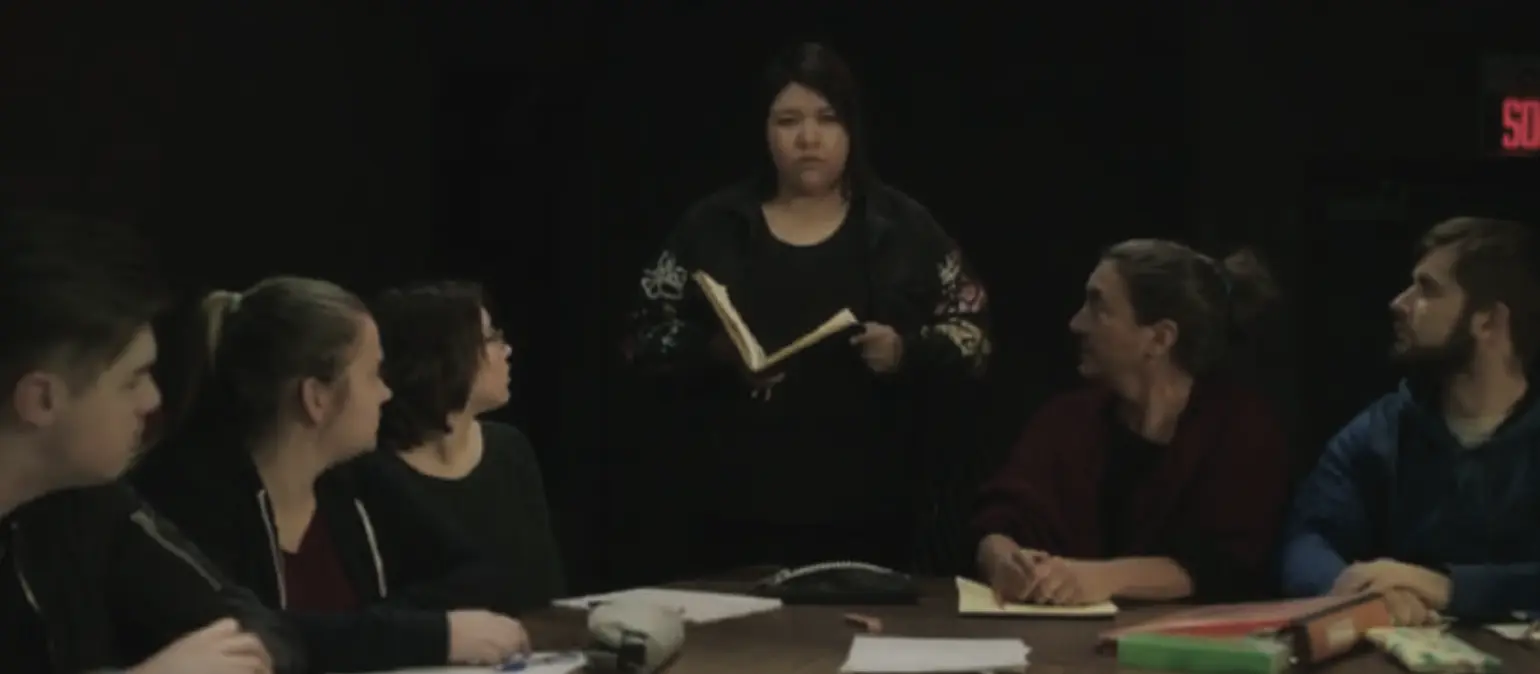
The notion of a plurality of perspectives, already inscribed in the plurivocal and polyvalent form of the novel, is central to the construction of the film as well. Kuessipan, after all, according to Fontaine, means “d’abord ‘à toi’, ‘à eux’, à ceux dont je parle,” inviting them to “exister en dehors des préjugés.”32 Fontaine explains why it was important for her to create so many strong characters:
Quand on parle des [A]utochtones, on a tendance à mettre tout le monde dans le même panier. Il fallait qu’on puisse voir la multitude des possibles. D’où l’importance de développer d’autres personnages comme Metshu, le frère de Mikuan, leurs parents, sa grand-mère ou le chum de Shaniss.33
This commitment to breaking with a monolithic dimension of alterity is also illustrated in a classroom debate where at least five different nuanced perspectives, all Indigenous, confront the hypothetical scenario of a company’s new request to mine in Innu territory. Mikuan’s “center of the world,” then, is not exactly meant to represent or coincide with Indigenous experience. She is not a proxy for the community, but rather a singular voice within it.
The Ethics of Form
Alongside its production process and narrative, Verreault’s formal choices also contribute to what I have been calling the “decentering of otherness.” I already underscored how the film’s poetic editing adds complex layers of meaning to each of its shots. I would like to turn now to two formal motifs that are central to the film’s ethics: the recurring presence of maps and the emphasis on the face. Kuessipan relies notably less on sweeping landscapes and scenes of nature that tend to feature prominently in Indigenous cinema. By contrast, the land around and beyond the bay is represented somewhat idiosyncratically through quasi-didactic maps: one is showed on the back of a restaurant kids’ menu, one in a train station and one on Google Maps, each with its own narrative purpose. The first is used by young Mikuan to trace her way to Uashat’s sister reserve of Maliotenam in order to reunite with Shaniss. It highlights the absurdity of the reserves, which end up separating not just settlers from First Nations, but also members of the same community or family from each other. The second map indicates the trajectory of the train during the aforementioned hunting trip and emphasizes the vast expanse of nutshimit within and beyond Québec. The third map allows Mikuan to wander down Québec City’s Rue Saint-Jean in “street view” as she dreams of moving there with Francis. The film’s cartography, especially as the Porte Saint-Jean comes into focus, again gestures toward the conflict between the short history of colonial settlement and the long history of First Nations presence. But yet again, Verreault leaves behind the narrative of victimization, as each time the maps represent the characters’ empowerment and moments of breaking out physically or imaginatively beyond the imposed boundary of the reserve. Young Mikuan is defying her parents’ refusal to take her to see Shaniss, who had been sent away to live with her aunt after a traumatic family incident. At what must be less than ten years old, she walks alone in the dark the over twenty kilometers separating her from her friend the next morning, a journey that testifies to her independence, courage and devotion to those she loves. The train map again conveys the cultural importance of hunting and the adaptability of the Innu in preserving elements of their traditional way of life. Finally, Mikuan’s virtual trip through Québec is accompanied by her voiceover about people finding “le chemin de leurs propres lois.” Like her brother’s success with hockey, Mikuan dreams of going to college and exploring her literary talent. Initially, she contrasts the mobility and anonymity of the city with the enclosure of the reserve and searches for an escape from a space she finds “too small” and stifling. But as the film progresses, her departure from the reserve becomes less a form of rebellious flight than a way to connect further with herself and her community and build pride in her Innu identity. It can be read in connection with the words of her final speech: “La fierté est quelque chose qui se construit. […] Si mes pieds se laissent attirer par l’ailleurs, si ma tête ne se lasse pas d’explorer l’horizon, je saurai toujours où mon cœur est attaché.” This, ultimately, seems to be the collective message of the maps. They retain certain reminders of domination, but they are also instruments of connection and openness to the world, as well as testimonies of adaptation that hold within them points of attachment of the heart.
The strength of this attachment is equally manifested in Kuessipan’s emphasis on the face, which constitutes the film’s most striking deconstruction of alterity. This deconstruction is achieved through a plethora of shots placing characters face to face, as well as through some particularly powerful close ups. The film itself begins with one of these masterfully crafted face-to-face shots. A mysterious, bluish light trembles in the center of the dark frame, then splits into two overlapping circles that continue to waver until they finally separate. Faint whispers can be heard amid the sound of crashing waves, followed by footsteps on pebbly sand. Ultimately, we realize these are headlamps on two bodies that emerge from the darkness and come into focus surprisingly close to the camera, such that the shot is unsettling. It is two little girls that have been walking toward the viewer and, when they finally become visible, they turn away from us and toward each other, smile and giggle. This moment, as the Vollant family enjoys an evening of fishing while on vacation, frames the entire film and the story of Mikuan and Shaniss’s fusional friendship. In this opening scene of joy and serenity, the girls literally shine light on each other, and in their playful and innocent gazes also lies their symbolic responsibility for each other. [Fig. 2] The later face-to-face shots of Mikuan and Shaniss that punctuate the film echo this initial moment and are almost always related to caring for one another: when young Shaniss is caressing Mikuan’s wounded hand; when Mikuan is consoling Shaniss after she has been beaten by Greg [Fig. 3]; when Shaniss is comforting Mikuan after her breakup with Francis [Fig. 4]. In spite of the diverging life paths of these characters, the deep bond signaled in these shots synecdochally figures the larger unbreakable solidarity of the community.
Mikuan’s relationship with Francis unfolds through many similar tightly framed face-to-face shots. In contrast with the equilibrium provided by this setup, Verreault films their breakup scene through a telephoto lens that slowly zooms out.
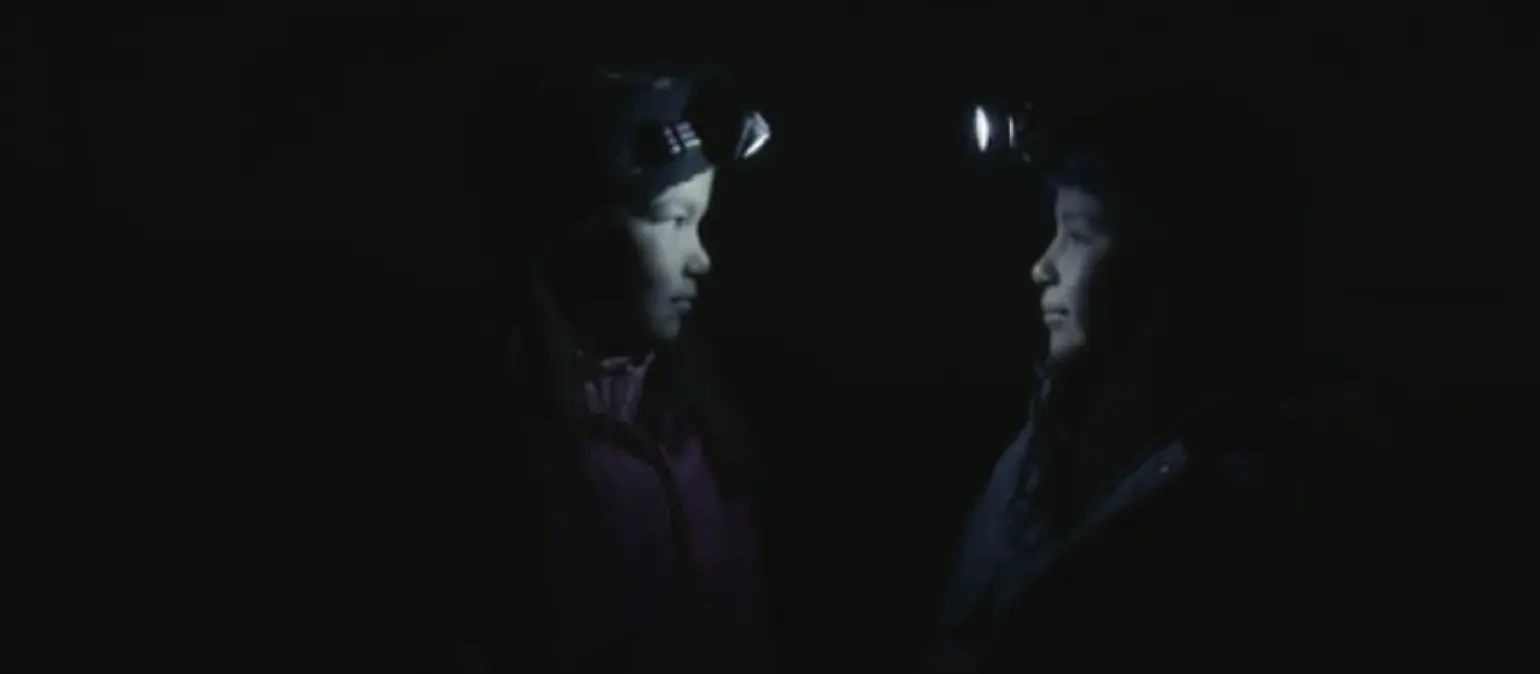

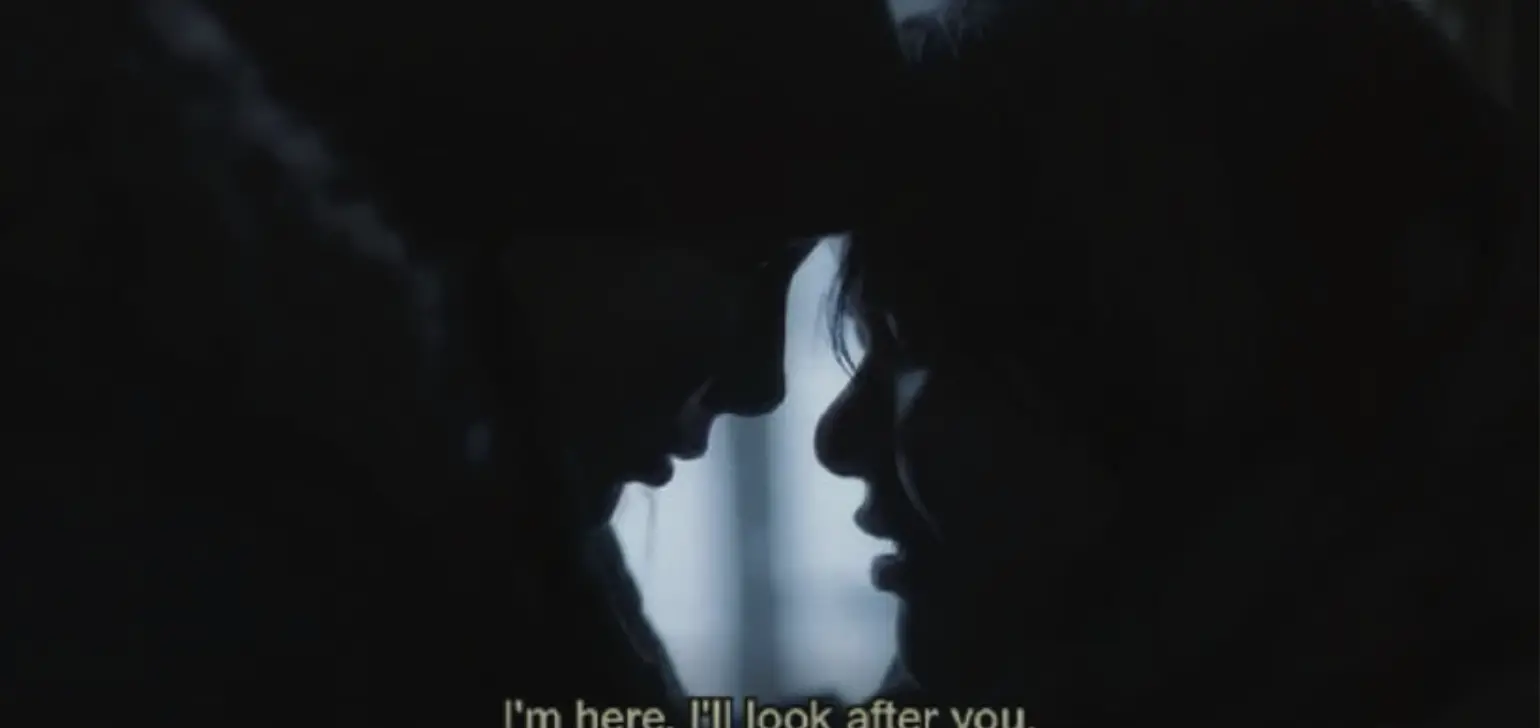
This technique deemphasizes their relationship and responsibility toward each other, gradually accentuating the environment surround- ing the two characters (Francis’s comfortable two-story house and garage). [Fig. 5] [Fig. 6] Mikuan is not only faced with Francis’s weakness and his failure to care for her after her brother’s tragic death, but also with a sudden feeling of being out of place as she distraughtly runs toward the camera. The spectator, thus, not only witnesses this scene narratively, but also through the disorienting affective break created by its form. We see as Mikuan feels and are moreover positioned in the direction of her flight, such that we are ethically interpellated by her vulnerability.


In addition to this face-to-face aesthetic, Kuessipan’s use of close ups is also particularly powerful. Two shots stand out through their narrative place- ment and arresting visual construction. The first is of Mikuan’s face, fragmented by a broken mirror as she is putting on makeup before her date with Francis. [Fig. 7] The shot is striking but ambiguous. We might be tempted to relate the image to the emerging fissures in Mikuan’s relationship with Shaniss, who calls her at precisely this moment to ask if she’d like to spend time with her.
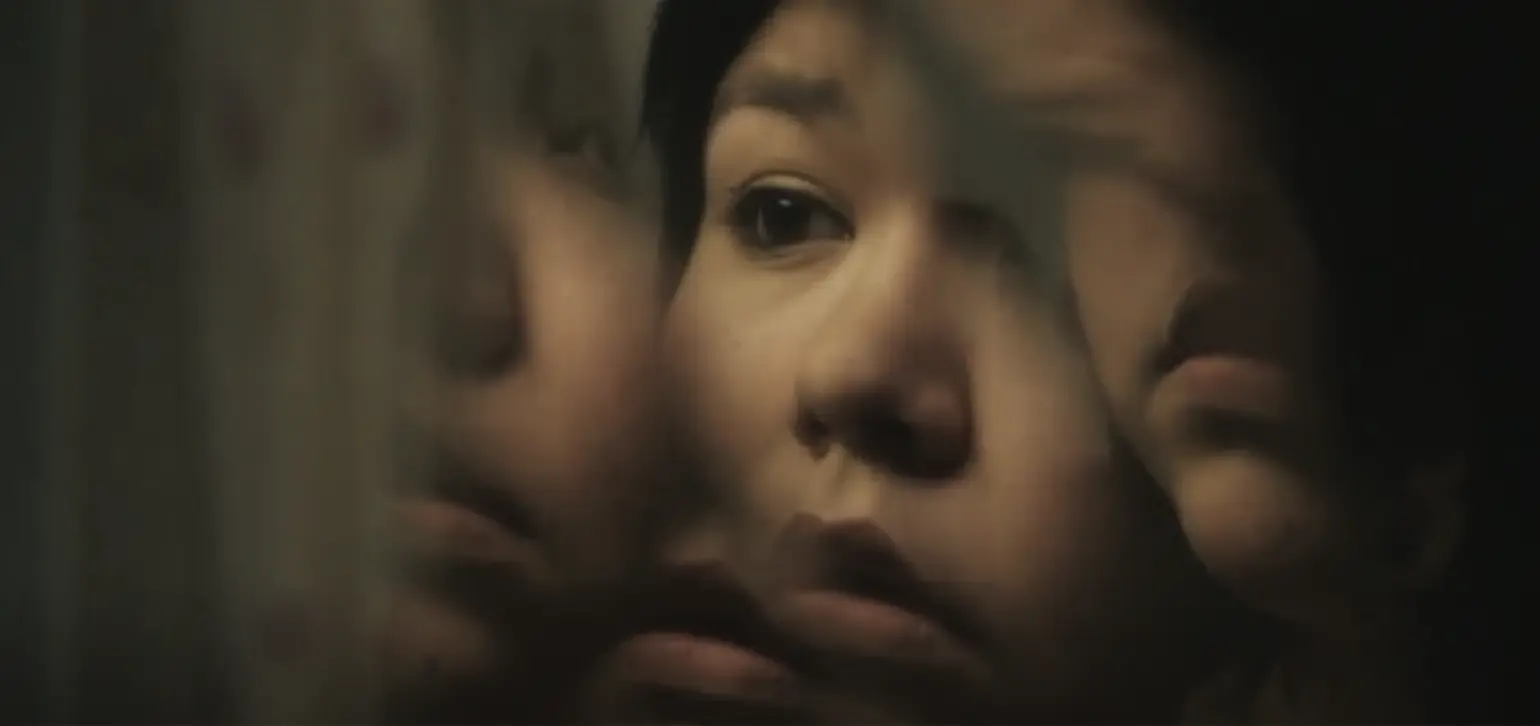
Mikuan lies to her friend to avoid mentioning Francis, and the multiplied images of her face seem to reinforce her duplicity in this moment. She also lies to her mother and removes the beaded earrings her mother has made for her as soon as she leaves the house. It is plausible, then, that the broken mirror reflects Mikuan’s momentary distancing from her identity and her cosmetic fashioning of an artificial, assimilated Self.
But an opposing interpretation is possible as well: the shot could in fact be an image of strength. In this respect, a link can be made with the remarkable visual poem by Katherina Nequado, Nin Tapwe/Authentique (2019), which is part of the Wapikoni Mobile’s collection. Nequado’s experimental film, evoking elements shared by Ralph Ellison’s Invisible Man (1952) and Ingmar Bergman’s Persona (1967), centers on the Indigenous woman’s body. The body is framed as a silhouette against different backgrounds and using different forms of lighting, such that it is at times separated into super-posed layers. A simple, rhythmic voiceover offers a series of affirmations with intertitles in Atikamekw: “Je suis femme/Je suis belle/Je suis forte/Je suis capable/Je suis intelligente/Je suis autochtone/On peut être visibles/ Car nous sommes fortes.” Just before the voiceover states “je suis autochtone,” a young woman’s somber face is framed as a reflection in the shard of a mirror, and, after a second, she smiles. [Fig. 8] We then see a different woman’s gaze reflected through cracks in a mirror, much like the way we saw Mikuan. [Fig. 9] In the following shot, the first woman reappears in a close up and removes a white mask from her face, looking directly into the camera.

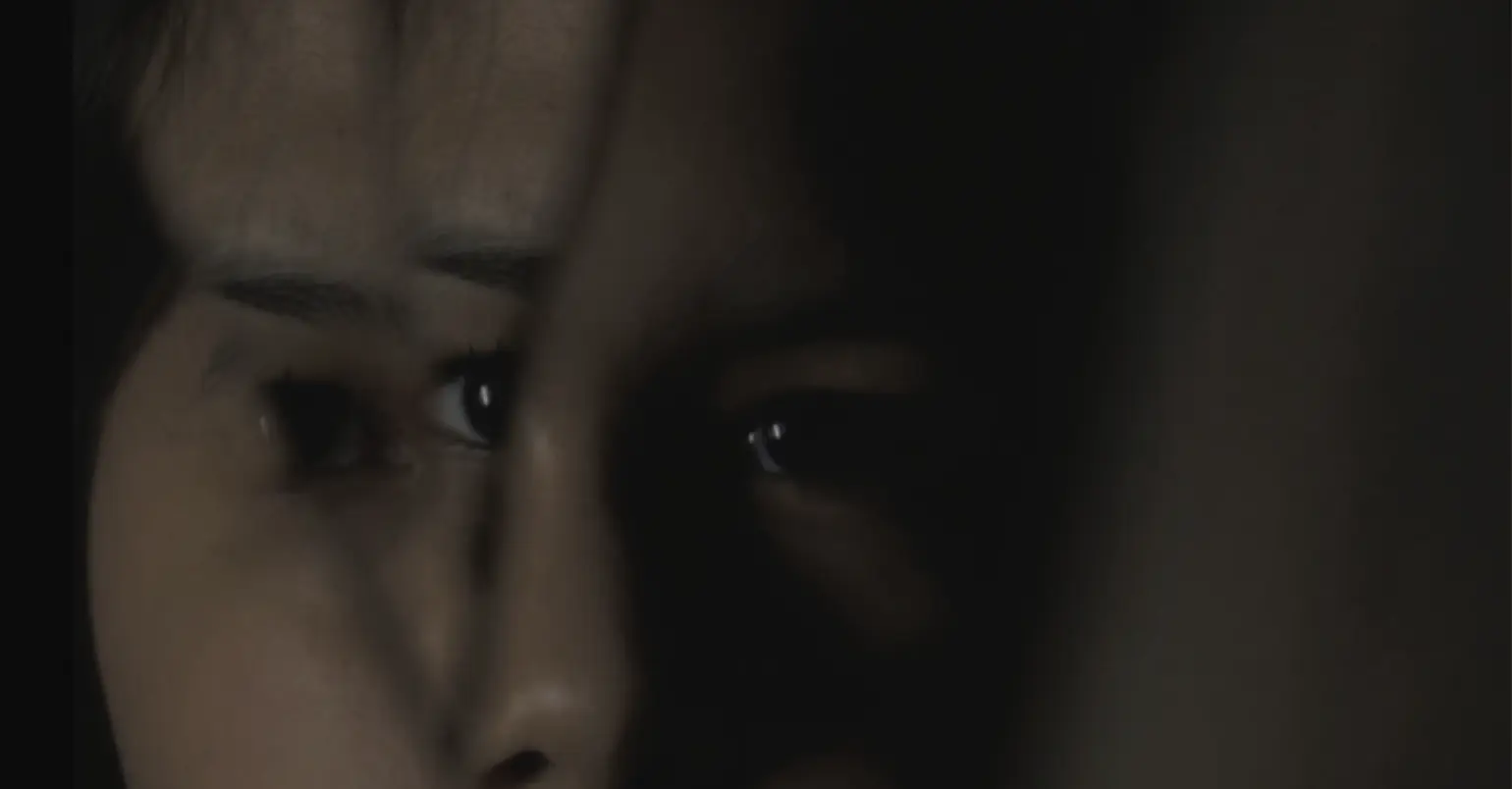
The connection between Nequado’s and Verreault’s images is likely just a fortuitous coincidence, but Nequado’s short can still productively inform our reading of Kuessipan. The fissured mirror is a material condition of deficiency external to the Self. Rather than allowing the “brokenness” to determine how the feminine subject views herself, rather than internalizing the cracks as part of her own self-image, Nequado invites the subject to see herself as whole despite and beyond the shards. More than this, in the vein of Franz Fanon, the mask suggests that seeing oneself through a white gaze creates the condition of brokenness to begin with. Taking off the white mask brings the woman back to her authenticity and allows her strength to be made visible. It could be, then, that the reduplicated fragments of Mikuan’s face—rather than signaling a moral failure, a state of disorientation or an identitarian fracture—might similarly highlight Mikuan’s strength in spite of external pressures. Read in this way, the shards reflect Mikuan’s independence and her ability to play different roles in order to follow her dreams while navigating the conflicting forces around her.
Kuessipan closes with an unexpected close up of Shaniss as Mikuan’s voiceover lyrically affirms the beauty of “la fille au ventre rond”:
Elle veut seulement, comme toutes les autres, faire des enfants. Une manière de faire grandir le peuple que l’on a tant voulu décimer. Comme une rage de vivre ou de cesser de mourir. Le vois-tu, ce regard qui brûle de l’intérieur? Des yeux d’Indienne, qui ont tout vu et qui s’étonnent de rire souvent.
As we hear these words, a heavily pregnant Shaniss enters a bookshop with her two young daughters, picks up Mikuan’s book, Nutshimit, and reads through it. Then, breaking with the diegesis, she looks directly at the camera for just a second before the screen goes black. [Fig. 10]

We should note that Fontaine’s tender description of “la fille au ventre rond” is one of the most memorable in the novel and that its many passages concerned with young mothers serve to displace Western stereotypes around teen pregnancy in Indigenous communities. Shaniss, despite the numerous struggles she must confront—including her mother’s alcoholism and her boyfriend’s abuse—, represents what Joëlle Papillon describes in detail as “la solidité des filles plutôt que leur victimisation.”34 Papillon explains that Indigenous maternity must be understood against the historical background of scoops and boarding schools, as well as forced sterilization. Fontaine’s description of motherhood in terms of love, beauty and revitalization of the community thus represents both empowerment and an alternative to hegemonic expectations of a linear organization of life.
Papillon explains that “la narratrice se libère de la grille d’évaluation à tra- vers laquelle les Occidentaux ont tendance à évaluer la valeur des filles et des femmes; cette ‘grille’ se base notamment sur l’apparence physique, mais aussi sur leur conformité à un parcours spécifique, dont la maternité ado- lescente est résolument exclue.”35 The close up of Shaniss’s gaze toward the camera thus captures the essence of Fontaine’s novel, with its shattering of stereotypes, but it also sums up the ethical imperatives of the film as a whole. It directly interpellates viewers, Indigenous and allochtone, with a delicate counter-gaze infused with strength and pride in spite of carrying the legacy of genocide. It is defiant, but also calls for responsibility and connection, for sharing the burdens of long history and building a hopeful future together. In this fleeting glimpse of the resilient “yeux d’Indienne,” in the eyes that we hardly have a chance to grasp or comprehend, we nevertheless understand that it is our turn.
Perhaps the scenes and aesthetic choices I have discussed here seem too subtle to have a tangible social or political impact. I would argue, however, that the relatively accessible hermeneutic engagement the film invites and the ethical imperatives that emerge from this active viewing process demonstrate the emancipatory powers of cinema at its best. I am speaking of cinema not as a dissemination of a clearly defined political message, but rather as what Jacques Rancière has termed dissensus, bringing “back into play both the obviousness of what can be perceived, thought and done, and the distribution of those who are capable of perceiving, thinking and altering the coordinates of the shared world.”36 The kinds of relational questions prompted by Kuessipan—Who am I? Where am I? What responsibilities do I have?— replace the Self/Other dichotomy with decentered notions of identity and alterity. In so doing, the authoritative legitimacy of the settler national narrative is transformed into a confrontation between short and long history, and in this decentered frame of reference, Indigenous peoples can no longer be “the Other” or even Others within: they simply are equals. As Indigenous cinema in Québec continues to flourish, viewers will increasingly find themselves face-to-face with the decentering aspects of cultural métissage and its potential to unsettle current distributions of land and power.
Author Biography
Ioana Pribiag is Assistant Professor of French at the University of Minnesota- Twin Cities, where she teaches francophone literature, postcolonial theory and cinema. Her recent work includes articles on Jacques Rancière, Marie Vieux-Chauvet, Michèle Lalonde, and Gaston Miron. She has co-edited a special issue on contemporary politics and political theory entitled The Locations of Politics (currently under review) and is working on a book manuscript called Shards: Spectacular Fragmentation in Francophone Postcolonial Literature.
Notes
- Bill Marshall, Québec National Cinema (Montréal-Kingston: McGill-Queen’s University Press, 2001), 262.
- For extensive overviews of First Nations productions in Québec, see Karine Bertrand’s “Le cinéma autochtone au Québec: de la représentation à la ré-appropriation,” Contemporary French Civilization 44.2–3 (2019): 221–240, and Miléna Santoro’s chapter “Reel Visions: Snapshots from a Half-Century of First Nations Cinema,” in Hemispheric Indigeneities: Native Identity and Agency in Mesoamerice, the Andes, and Canada, Miléna Santoro and Erick Langer, eds. (Lincoln: University of Nebraska Press, 2018), 323–359.
- Michelle Raheja’s concept of “visual sovereignty” generally provides the theoretical background for readings of Native cinematic productions. It refers to “the space between resistance and compliance wherein Indigenous filmmakers and actors revisit, contribute to, borrow from, critique, and reconfigure ethnographic film conventions, while at the same time operating within and stretching the boundaries created by those conventions.” See Michelle Raheja, Reservation Realism: Redfacing, Visual Sovereignty, and Representations of Native Americans in Film (Lincoln: University of Nebraska Press, 2013), 193. Laura Graham also suggests a shift in vocabulary toward “representational sovereignty.” This not only opens the discussion to Indigenous embodied performance and audio, but also avoids “privileging the visual mode and honors the importance of sound in Native ideology and practice.” See Laura Graham, “Toward Representational Sovereignty: Rewards and Challenges of Indigenous Media in the A’uwẽ-Xavante Communities of Eténhiritipa-Pimentel Barbosa,” Media and Communication 4.2 (2016): 14.
- Marshall, Québec National Cinema, 262.
- Bertrand, “Le cinéma autochtone au Québec: de la représentation à la ré-appropriation,” 223.
- Karine Bertrand, “Cinéma inuit et post-colonialisme: la revendication de la parole des femmes dans le film Le jour avant le lendemain (2008) de Marie-Hélène Cousineau et Madeleine Ivalu,” in French Cinema 13.3 (2013): 211.
- Raheja, Reservation Realism, 202.
- Raheja, Reservation Realism, 194.
- Kerstin Knopf, Decolonizing the Lens of Power (Leyde: Brill, 2008), 63, the author’s emphasis.
- Santoro, “Reel Visions,” 326.
- Kwame Anthony Appiah, “Is the Post- in Postmodernism the Post- in Postcolonial?,” Critical Inquiry 17.2 (1991): 354; 356.
- See Laurent Dubreuil, Empire of Language: Toward a Critique of (Post)colonial Expression (Ithaca: Cornell University Press, 2013), 65–75.
- Michael Gott and Thibaut Schilt, eds., Cinéma-monde: Decentred Perspectives on Global Filmmaking in French (Edinburgh: Edinburgh University Press, 2018), 10.
- Gott and Schilt (eds.), Cinéma-monde, 8.
- “Entrevue avec Myriam Verreault (réalisatrice-scénariste) et Naomi Fontaine (co-scénariste et auteure du livre Kuessipan),” https://www.kuessipan.com/presse (consulted on 17 January 2022).
- Naomi Fontaine, “Le français vu par Naomi Fontaine,” Cégep Édouard-Montpetit (27 February 2020), https://www.youtube.com/watch?v=CImx_o6UvOI (consulted on 15 January 2022).
- “Dossier de presse,” Filmoption international, https://www.filmoptioninternational.com/s/ Kuessipan-Dossier-de-presse-FR.pdf (consulted on 23 February 2022).
- Marc-André Lussier, “Kuessipan de Myriam Verreault : à toi. Et à moi.,” La Presse (30 September 2019), https://www.lapresse.ca/cinema/entrevues/2019–09-30/kuessipan-de-myriam-verreault-a-toi-et-a-moi (consulted on 15 January 2022).
- “Dossier de presse.”
- Lussier, “Kuessipan de Myriam Verreault”.
- Charles-Henri Ramond, “Entrevue avec Myriam Verreault,” Québec Cinéma (3 October 2019), https://quebeccinema.ca/la-une/entrevue-avec-myriam-verreault (consulted on 15 January 2022).
- Homi K. Bhabha, Location of Culture (London: Routledge, 1994), 21.
- “Dossier de presse.”
- Barry Barclay, cited Stephen Turner, “Reflections on Barry Barclay and Fourth Cinema,” The Fourth Eye: Maori Media in Aotearoa New Zealand, Brendan Hokowhitu and Vijay Devadas, eds. (Minneapolis: University of Minnesota Press, 2013), 163.
- Turner, “Reflections on Barry Barclay and Fourth Cinema,” 164.
- Fontaine, “Le français vu par Naomi Fontaine.”
- Fontaine, “Le français vu par Naomi Fontaine.”
- Caroline Desbiens, Power from the North: Territory, Identity and the Culture of Hydroelectricity in Québec (Vancouver: University of British Columbia Press, 2014), 2.
- Desbiens, Power from the North, 2.
- Turner, 163.
- Turner, 163.
- Fontaine, “Le français vu par Naomi Fontaine.”
- “Dossier de presse.”
- Joëlle Papillon, “La solidité des filles chez Naomi Fontaine,” Tangence 119 (2019): 42.
- Papillon, “La solidité des filles chez Naomi Fontaine,” 43.
- Jacques Rancière, The Emancipated Spectator, translated by Gregory Elliott (London-New York: Verso, 2009), 49.
